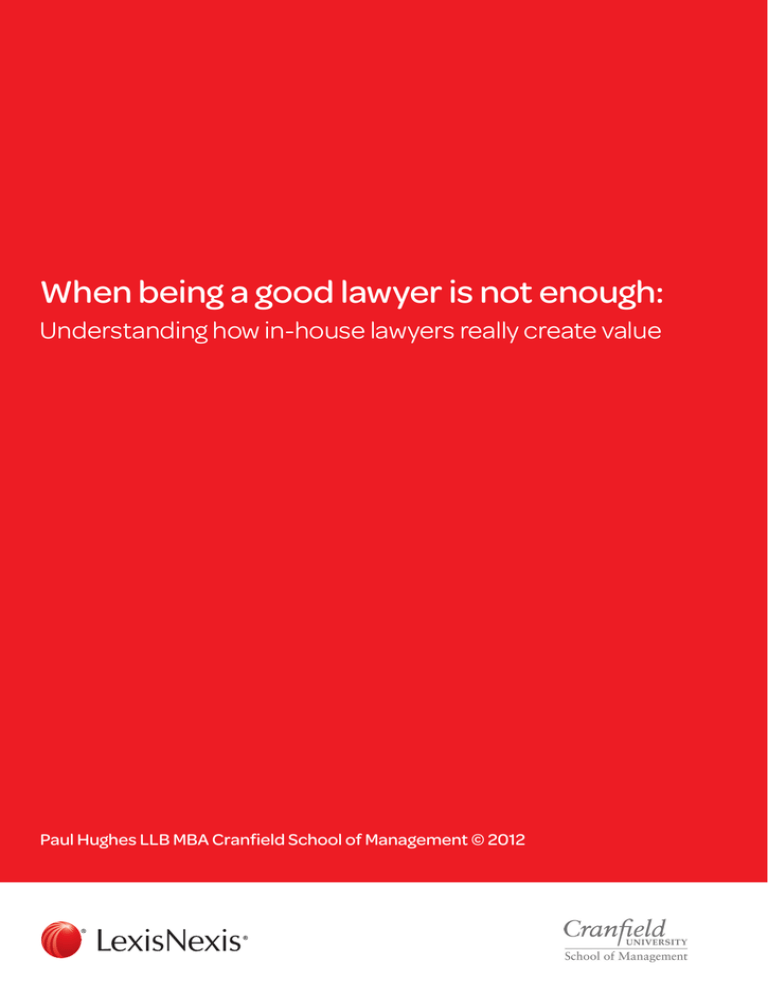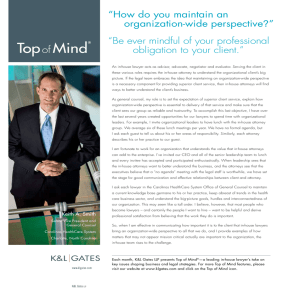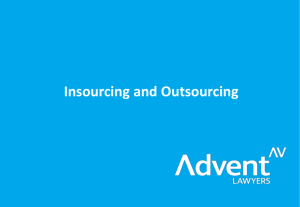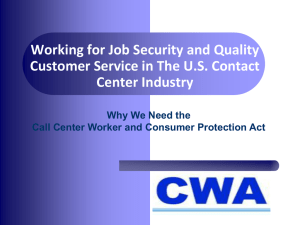When being a good lawyer is not enough:
advertisement

When being a good lawyer is not enough: Understanding how in-house lawyers really create value Paul Hughes LLB MBA Cranfield School of Management © 2012 Contents Foreword................................................................................................................................... 3 Do you really understand how in-house lawyers create value?.................... 4 Why creating value can be difficult in-house.......................................................... 4 Sources of true value: which activities are key?..................................................... 5 The capabilities underpinning the activity................................................................7 Effective advice..................................................................................................................... 8 How to deliver service?...................................................................................................... 8 The nature of in-house legal service........................................................................... 8 Putting it all together to maximise in-house legal value creation.................. 9 2 Foreword The role of the in-house lawyer has never been more important, more visible or under more scrutiny than it is today. With the raft of high profile corporate failures coupled with ethical and regulatory breaches, many of those outside the organisations are looking on and asking questions about the lawyer’s role in corporate governance. Within the profes-sion, law firms are waking up to the fact that a structural shift is happening in their market, and a subtle shift in the dynamics of power between the firms and their corporate clients is underway. There is no doubt the role of in-house lawyer is becoming more critical and potentially much more influential. However, while the number and quality of in-house lawyers continues to increase, often the impact of the inhouse lawyers is muted. Overwhelmed by day-to-day fire-fighting, struggling to understand complex and fast moving corporations with rich webs of stake-holders, and constantly reminded of the need to do “more with less” perhaps this is un-derstandable. Over the past 18 months, we at LexisNexis spoke to well over one hundred in-house law-yers across the UK to understand the corporate legal landscape in real depth. We lis-tened as corporate counsel talked about their work, their challenges and their successes. Some key themes emerged, and one of those that in-house lawyers spoke most passion-ately about, was the need to really create value for their organisations. For the newer in-house lawyers, the message that came through most strongly was just how difficult this was, not least because while plenty of people talked about “adding value” nobody really seemed to know what it meant. For the senior lawyers who had been in the trenches a while, a genuine desire to develop their teams came through alongside a desire from some to take that final step to become seen as a genuine leader in their organisations. In all cases, there did not seem to be an obvious solution to those problems. Mark Smith Director of In House Legal Markets Lexis Nexis, 2012 Do you really understand how in-house lawyers create value? In-house lawyers have a vital role to play in how organisations create value, but how this happens is often not understood both by the employing organisations and the in-house lawyers themselves. Cranfield School of Management and LexisNexis joined forces to find the answer to this question so that they could help in-house lawyers and the organisations that employ them develop and enhance this capability. The existing research revealed a lack of insight into what activities that in-house lawyers carried out actually added value, and what capabilities were needed in order to execute these activities in the most successful way. This paper answers these critical questions. Why creating value can be difficult in-house The work of an in-house lawyer is typically a ‘secondary activity’ - it is rarely part of the primary commercial offering of an organisation. The separation from the ‘workings’ of the organisation can lead to the in-house lawyer being seen as not as much an ‘insider’ as others in the organisation, and can be a huge culture shock to a lawyer moving from a law firm, where the lawyers are the key revenue producing asset. The picture is not quite so clear cut though, because in many organisations, far from being seen to be “just another back office function”, the role often comes with a ‘special status’, which sees the professional standing of the in-house lawyer highly respected and valued. This status can be a double edged sword because coupled with the need to operate as the ‘legal conscience of the organisation’ it can exacerbate the high degree of isolation for many in-house lawyers. This isolation may inhibit the value that an in-house lawyer can add. 3 Another challenge comes from the fact that most (over 90%) in-house lawyers will have acquired their professional status with little or no experience within a non-legal organisation. This creates a significant knowledge and experience gap that requires effort and work to overcome and makes life tough for in-house lawyers as they have a significant learning curve to climb just to get on the same page as many of their organisational peers. Another important consequence of being developed in a private practice law firm, is that many of the nuances and subtleties of managing, developing and motivating people, as well as the procedural demands, are not always as well understood. This is a very different palette of individuals and stakeholders than typically found in a legal organisation: for an In-house lawyer it is typically a wider, more complex and diverse group. Intellectually they are typically grasped with some training, but the experiential steps in motivating and leading others in non professional service environment is something few have been a subject of themselves: this creates a second experience curve many in-house lawyers need to scale. Against this challenging backdrop, the value that in-house lawyers are expected to add is increasing constantly with work increasing in both complexity and volume. Recent years have seen in-house team grow but this is often set against a drop in external legal spend, so the amount of work per in-house lawyer is increasing at a faster rate than the number of in-house lawyers. Sources of true value: Which activities are key? With so many demands on an in-house lawyer’s time, it can be difficult to know where to focus, particularly as there is always the risk of being swept along by day to day events. A solid starting point is to understand which activities create value for organisations. Our research found five of these: • Being a skilled lawyer • Reducing the cost of service delivery • Providing a service that reduces the organisation’s loss of profit margin • Providing a service that contributes to greater overall value of organisational service • Providing the corporate legal conscience – ‘The Ethical Champion’ The skilled lawyer is the ‘technical’ legal service that an in-house lawyer provides. Critically (as we will see below) it is not wholly “technical” in the sense of a focus on “black letter law” – rather it incorporates a deep understanding of the organisation and the commercial environment in which it operates. This activity was described as the ‘optimal legal solution being identified and deployed in the best way for the situation the organisation faces’. Critically, this advice could be of the highest quality (as determined by an In-house legal peer group) yet this level of service is classified as an organisation as a ‘given’. New in-house lawyers often fail to understand that giving the correct advice is expected as a minimum by organisations and while undoubtedly a source of value, is rarely seen as adding value. Reducing the cost of the delivery of the in-house legal service is perhaps the most frequently found source of added value from in-house counsel. It is the model on which most performance management systems and KPIs for Inhouse lawyers are based, and can result in the classic behaviour of the in-house lawyer doing as much as they can themselves for as little cost as possible. It can also encourage the in-house lawyer to develop a replica of a private practice firm inside the organisation: but without the financial and status reward that such hard work and dedication brings the parts of corporate law firms. Providing a service that reduces loss of organisational profit margin adds more value than solely providing legal services at the lowest cost. This is because the legal function can create outcomes where much larger costs are saved; typically through effective commercial dealings or dispute management. How good the quality of the technical solution was, how intricate and skilled the lawyer, or not, is irrelevant to non legal stakeholders. It is the amount of money in this situation that was recovered. 4 “An imaginative in-house lawyer, besides reducing legal expenses and freeing up manager’s time that might otherwise have been spent on legal problems, can use law to create business opportunities that contribute directly to the company’s profitability” Samuelson, 1987 in Sloan Management Review This means that sometimes even though something is legal, it could still come with a ‘no’ recommendation, if the In-house lawyer wants to add the most value. To do this there must be an understanding of the organisation, its market or environment and the concept of risk and probability. The highest amount of value that in-house legal teams can deliver typically comes through contributing to creating a greater overall value of organisational service. This is where the activities of the legal function lead to the organisation being able to deliver a higher value outcome itself, leading to higher revenues if a private organisation or reputational value if a non profit one. This is the pinnacle of how value can be added by the In-house legal function but also the least common. In-house lawyers who add value in this way also had the highest levels of influence in the organisations in which they operated. For example helping an organisation seek licence opportunities for revenue from Intellectual Property that they may not realise has market value, or helping software organisations balance how they sell licences so that maximum revenue can be achieved through careful management of contracts. Many other ways exist, but the value adding In-house lawyer is involved enough in the organisation to be seeking out opportunities. They also develop the confidence to know that not all will succeed, but that is less important than being seen to try. The final activity of providing the corporate legal conscience - or being the ‘Ethical Champion’ – involved less clearly defines cause and effect in creating value, but was viewed very positively by those inside organisations. This was seen as a quality that helped ensure less short term thinking in organisations, greater objectivity and maturity in decision making, when it was at its most value adding. High Added Value Providing a service that contributes to greater overall value of organisationl service Providing a service that reduces organisational loss of margin Reducing the cost of service delivery The Skilled Lawyer Low Added Value Little influence and impact Significant influence and impact 5 The Capabilities Underpinning the Activity If these were the key activities for value creation, what capabilities do In-house lawyers need to deliver these effectively? We identified that all In-house lawyers had five basic dimensions when discharging their roles, which varied across individuals and organisations. Two were focused on what they did and the service they provided, two were focussed on how they provided their service and the last was focused on the nature of that service. These five dimensions are: • The Legal Expertise Dimension • The Business Expertise Dimension • The Independent Function Behaviours Dimension • The Collaborative Function Behaviours Dimension • The Ethical Champion Dimension The ‘Ethical Champion’ sits at the core, but it is when In-house lawyers demonstrate more than just capability in Functional Behaviours and Legal Expertise that starts to be added, beyond cost of service delivery control. Only when an In-house lawyer can comfortably and capably demonstrate capability in either Business Expertise or Collaborative Behaviours, will they begin to make meaningful progress in the key value creating activities – and with it demonstrate increasing influence and impact. Business Expertise Adding Value Creating Value Ethical Champion Functional Behavious Reducing Costs Collaborative Behavious Adding Value Legal Expertise Hughes, 2012 Those with capability solely in the bottom left corner will largely be limited, except in special organisational circumstances, in the value they will be able to add. The In-house lawyers that demonstrated capability in all areas of the model were in all cases those who added the greatest value and had the greatest level of influence. 6 Effective advice In-house lawyers are able to provide advice on legal matters (‘Legal Expertise’), on business matters, (‘Business Expertise’) or both. Legal Expertise is that part that is a ‘given’ for an in-house lawyer. This encapsulates the ‘hard’ or ‘technical’ type activity of the ‘The Skilled Lawyer’ outlined earlier. The capability derived from the knowledge, skills and understanding of a ‘technical’ subject area and the ability to apply it. In-house lawyers who only focused on this aspect of their role added value, but nowhere near as much as those who also demonstrated capability in the dimension of Business Expertise. This aspect, similarly to ‘Legal Expertise’ relates to capability on understanding and insight regarding the organisation itself and the environment in which it operates. Those in-house lawyers who demonstrated capability on both are those adding more value than those solely demonstrating capability on Legal Expertise alone. Even those who demonstrated just a small amount of capability in the Business Expertise dimension could add much more value than those who only focused on the area of adding value through Legal Expertise. How to deliver service? The how dimensions relate to the way that Legal Expertise and Business Expertise are delivered. This includes the style of communications, interactions, managing relationships, attitudinal and other behavioural approaches involved in delivering their service. The in-house legal functions that delivered solely in an “Independent Functional Behavioural” style would operate with a high degree of isolation from other functions and were far less value adding than those who operated in a “Collaborative Functional Behaviours” style. Those that developed this second aspect add value by being invited at earlier stages to be involved and informed in where activity that would ultimately require a legal perspective was initiated. The nature of in-house legal service The final dimension was that of the nature of the overall service provided, which was a constant across all the research sites and regardless of what or how the service was delivered. The ‘Ethical Champion’ is a dimension that emerged repeatedly as intangible but openly recognised aspect of the added value of the In-house lawyer, the feeling that ‘they have my back’, or ‘it has that stamp of approval’. 7 Putting it all together to maximise in-house legal value creation So how do you put this into practice? How would you go about developing the capability of the In-house team to add more value, using this insight? 1. The in-house legal function have to lead this process. Where the greatest value adding activity was found was always initiated by discretionary leadership of those in In-house legal functions. This means the change has to start from the in-house team itself. However it also means that organisations have to open the door for this debate with their in-house legal team. 2. This is a capability issue, not a systems and processes one The temptation to process map and implement a solution could be tempting, but it is extremely unlikely to work. This is because without providing in-house lawyers with the capabilities needed to deliver the activities it is likely to become another ‘box tick’ solution. In no examples during this or other research had systems and process change alone led to change in the way in-house legal teams add value. That doesn’t mean that these aren’t very important considerations: they are but they are more often significant as they are a barrier. These need to be identified and changed if more value adding capability and activities are to arise. 3. Work to Establish the Right Metrics, Processes and Systems While it is tempting to see Metrics, Processes and Systems as being the solution, this should not be the starting point for developing this area. These can be used to support the solution, for example by being adjusted to what is required for in-house lawyers and to add more value. But the solution begins with the capability first and the supporting processes and metrics second. Worse, they could lead to people playing the system and not really understanding why they are trying to change. 4. Business Insight is a critical building block Develop Business Insight first, and use this to support greater Collaboration. Forcing in-house lawyers into closer proximity with other non legal stakeholders when they haven’t developed greater Business Insight is unlikely to lead to the most constructive returns. Conversely developing Business Insight will enable an immediate improvement in the activity of being a skilled lawyer and work to reduce isolation by breaking down some of the barriers to understanding the commercial and organisational context in which they operate. 5. Accept that investment is required More and more examples of in-house lawyers are being found who add greater value to organisations. In order to mimic this it is necessary to invest in developing in-house lawyers in a different way. Removing perceived objections to this will be necessary if they are to learn the Business Expertise that they need. Collaboration is a lower cost investment as the principles are easily identified and learned (though not always easily applied). But Business Expertise will attract a higher level of investment as it involves knowledge transfer of a higher magnitude: and that comes at a cost. 8 A division of Reed Elsevier (UK) Ltd. Registered office 1-3 Strand London WC2N 5JR Registered in England number 2746621 VAT Registered No. GB 730 8595 20. LexisNexis and the Knowledge Burst logo are trademarks of Reed Elsevier Properties Inc. © LexisNexis 2012 1012-032. The information in this brochure is current as of October 2012 and is subject to change without notice. Cranfield School of Management © 2012




